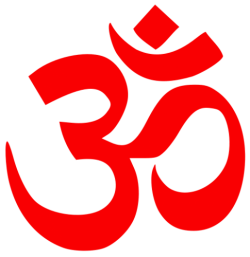Aum or Om Symbol

Aum or Om (in Devanagari ॐ) is one of the most sacred symbols in Hinduism. In Sanskrit known as praṇava (प्रणव) lit. "to sound out loudly" or oṃkāra (ओंकार) lit. "oṃ syllable")
Hindus consider Aum to be the universal name of the Lord and that it encompasses all of creation. It is made up of the letters A (as in "around"), U (as in "put") and M (as in "mum"). The sound emerging from the vocal cords starts from the base of the throat as "A." With the coming together of the lips, "U" is formed and when the lips are closed, all sounds end in "M." The "amen" in Christianity and the "ameen" in Islam and "aum" may show a common linguistic ancestry within the Indo-European language group and it is conjectured that the Aum mantra may have travelled from the East to Europe changing its form and context. Judaism contains the first recorded use of "amen" in the context of a response by the congregation to the priest's prayer. Judaism defines the Semitic verb "amen" as meaning "to be trusted".
Om symbolizes The Supreme Personality of Godhead i.e Parabrahman. It symbolizes the prana or life breath with runs through one's body bestowed by the Parabrahman. The significance and explanation of Om is given in the Mandukya Upanishad.
Hindus believe that the entire essence of the Vedas (ancient Indian scriptures) is enshrined in the word Aum. The belief that the Lord started creating the world after chanting "aum" and "atha" gives this religious symbol a fundamental relevance to the Hindu view of creation. Hence, its sound is considered to create an auspicious beginning for any task that one may undertake.
© Symbols.com
